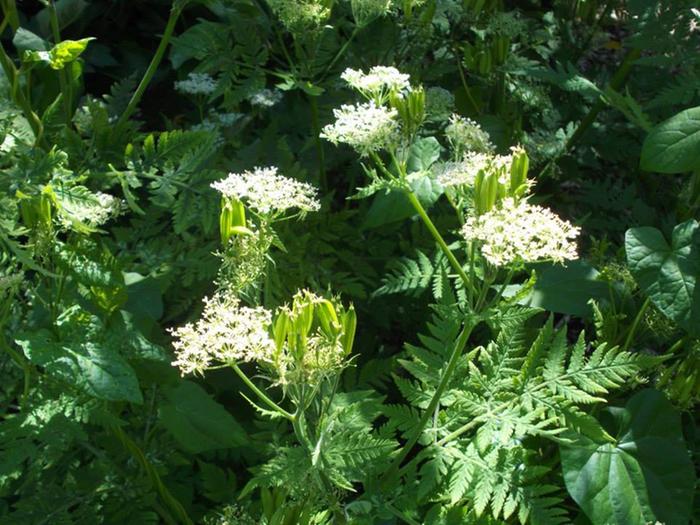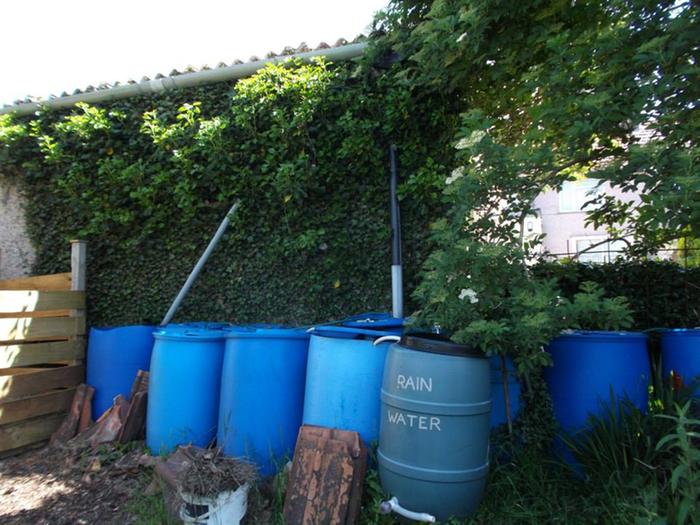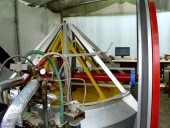My son and I went back to the UK for a few days last June, and we managed to time it just right to visit the
Easton Community Allotment in Bristol, run by Cristina Crossingham, whose brother is the famous UK
permaculture guru Patrick Whitefield, author of
The Earth Care Manual. We set out in the morning and finally, after a wild goose chase involving the wrong Gordon Road on the wrong side of Bristol, followed by a walk up Stapleton Road wondering if anyone actually knew where the real Gordon Road was, we gave up in despair, got in a taxi, and found this warm welcome to Commallot.
.jpg)


The lettuce barrow and new raspberry bed.
Cristina says
"We grow autumn raspberries as the birds have full tummies by the time they fruit so we dont have to net them. Netting fruit is very boring."
 "The nearby business park, a reminder that we are in the middle of the city."
"The nearby business park, a reminder that we are in the middle of the city."

Having been in Portugal for eight years, the first thing that struck me about the beds was the lack of mulch. With our dry summers, I do my utmost to cover every bit of bare earth around my plants to try to conserve moisture and build the soil. But then I remembered slugs. Without those dry summers, conserving moisture isn't much of a a problem, but the slugs soon become a major pest and mulch is a perfect breeding ground for them.
It's a good reminder of how
permaculture is not just a set of instructions, but a whole tool-box that we have to choose the most appropriate tools from to suit our needs and environment.
The second thing I thought was
'Mmmm - broad beans...', while my son said '
Oh god, not more bloody favas...'
"We compost the beds and cover them with cardboard during the winter so they are crumbly and moist when we open them up and evict the slug colony that moves in."


Rhubarb! I miss this stuff. In theory it will grow in Portugal but we've tried and failed many times. Those pots are for 'forcing' it to grow tall and straight and mild and juicy as it reaches up for the light. Om nom nom, I'm getting hungry just thinking about it...
"I have let this old rhubarb flower this year just to enjoy the exotic seed heads. Our producing rubarb is now beside the shelter as it doesnt mind a bit of shade."

And where there is rhubarb, there
should always be sweet cicely to serve with it. The leaves are sweet and slightly scented and can be chopped up and mixed with rhubarb as it cooks. Even I can't eat rhubarb without some form of sweetener.
I also have a slight admission to make - I couldn't resist pinching one or two of those seed pods. At this stage you can eat them whole and they are like little aniseed-flavoured
pea pods. Later, the pods get too chewy and hard and you have to take the seed out to eat separately. We can't grow this in Portugal either, and it's been a long, long time since I'd tasted it...

The
water containers with top and bottom removed and vaselene smeared around the tops protect the courgette plants from slug damage when young. They also give some shelter from the wind, a miniature micro climate.

The raised beds are good if you cant bend down far but the soil in them is noticeably
dryer than in the others.
hugelkultur
 "Sadly neglected herb area but most of our herbs put up with the bad treatment and flourish."
"Sadly neglected herb area but most of our herbs put up with the bad treatment and flourish."

Resting and admiring your work is as important as anything else here. I just love the little bench...

Almost everywhere I looked, more comfrey seemed to popping up. And there, lurking in the shadows near the
fence, is another old favourite I've failed to grow for years - gooseberries!

Gooseberries!

Ruby chard, going to seed.
Seeing this being allowed to set seed was especially poignant for me as we had recently been accosted by several members of our village when they saw that we had 'acelga' seedlings. There is a strong tradition of saving all your own seed in Portugal, and somehow everyone in our village had managed to lose their lines of acelga/chard so no-one has grown it here for years. One neighbour spotted Les with some and begged four plants off him, then later asked me if we had any more, then more neighbours got to hear of our riches and we ended up supplying the whole village with plants. How many other plants have been lost like this? And how many will be lost in the future if we don't pay attention to saving our own seed?

Runner beans netted because of the recent winds they couldn't climb the poles. Nearly at the top now.
 "Chive flowers. Pull them apart and add to salad for an intense chive flavour. Red lettuce is disliked by slugs. I found a couple nestling under the leaves and NO DAMAGE. Red lettuce tastes good too. OLE!"
"Chive flowers. Pull them apart and add to salad for an intense chive flavour. Red lettuce is disliked by slugs. I found a couple nestling under the leaves and NO DAMAGE. Red lettuce tastes good too. OLE!"
 "The infant woodland garden. The soil is very thin as it covers all the concrete removed from the allotment when it began in 2001"
"The infant woodland garden. The soil is very thin as it covers all the concrete removed from the allotment when it began in 2001"

What a lovely place for everyone to sit down and help with the potting.
 "Our compost loo is very fragrent even tho untouched since its beginning 10 years ago. We do put most piss on the compost as an activator tho."
"Our compost loo is very fragrent even tho untouched since its beginning 10 years ago. We do put most piss on the compost as an activator tho."

"
All the water used on the allotment is collected off this roof and fed into barrels. We get drinking water from a tap on the Packers Annex nearby as we have no mains water on site."

A siphon system ensures that as many barrels as possible are filled when it rains. And just look at that elder! I do love elder...
 Roots
Roots? I didn't understand, so I asked Cristina.
"The ROOTS bin is where we put bindweed and creeping buttercup etc roots. After a year under water they are dead and get added to the compost bin. The water has nutrients so it goes on the crops. If you keep every scrap of green out of the root bin it doesn't smell so bad but this never happens so emptying it is the least lovely task on the Lotty."

Roots of tough weeds tend to grow if composted, so they are put in this barrel to rot down completely.

More comfrey.
"There is wild comfrey all over and as it has viable seed it is quite hard to control. This year we are beginning two beds of Bocking 14 roots which dont set viable seed."
 "Comfrey juice is used as a fertliser, and some is also sold to raise funds. The comfrey rots down into a liqued and is drawn off via the tap at the bottom. We dont add water so we get a thick black concentrated liquid to dilute later. The advantage is that it smells sweet."
"Comfrey juice is used as a fertliser, and some is also sold to raise funds. The comfrey rots down into a liqued and is drawn off via the tap at the bottom. We dont add water so we get a thick black concentrated liquid to dilute later. The advantage is that it smells sweet."

Comfrey in the comfrey bin.
 "We have a couple of heaps of prunings and woody stuff which we just add to each year. Good habitat for creatures and the rotting process adds biodiversity. Plenty of useful pallets from nearby printing works, always useful."
"We have a couple of heaps of prunings and woody stuff which we just add to each year. Good habitat for creatures and the rotting process adds biodiversity. Plenty of useful pallets from nearby printing works, always useful."
 "Woodchips are donated and used as mulch on the paths. In the background, old fridge filled with grass sods, covered while they rot and planted with squash this year."
"Woodchips are donated and used as mulch on the paths. In the background, old fridge filled with grass sods, covered while they rot and planted with squash this year."

Wildlife area. Old barrow on the left. Planted with lettuce and nasturtiums.
 "Ivy clad dead tree. Not removed as it provides more biodiversity, home for insects and perch for birds."
"Ivy clad dead tree. Not removed as it provides more biodiversity, home for insects and perch for birds."

One of the ponds, filled with water plants. First flag iris on the right, since many more have flowered.

We think this is to be water avens. Apparently you can make a chocolate type drink out of it and it's good for excessive menstruation. I think I could use a plant like that...
http://herbs-treatandtaste.blogspot.pt/2011/05/water-avens-indian-chocolate-ancient.html

The community shelter.

Well labelled compost bins, so everyone knows what to use, what to add to, and what to leave alone. These are new this year replacing the 10 year old collapsed ones which were made mostly of pallets.


Old fridges are re-used as grow beds.
"This one is too much in the shade. Optimistic to think the poor plant may be able give us courgettes."

The garden shed.
 "Old pallets are recycled into compost bins, and old compost bins are recycled into firewood. Bricks from Broadmead shopping centre are recycled into a rocket stove which keeps the volunteers supplied with hot water for tea and soup."
"Old pallets are recycled into compost bins, and old compost bins are recycled into firewood. Bricks from Broadmead shopping centre are recycled into a rocket stove which keeps the volunteers supplied with hot water for tea and soup."
 "The shelter is the heart of our Lotty. We share lunch there every Thursday"
"The shelter is the heart of our Lotty. We share lunch there every Thursday"
And there is that rather awesome chocolate cake! I do love
chocolate, and apologise wholeheartedly for my totally inappropriate comment. I must learn to think before opening my mouth in mixed company.

Tea time
 "Slipping very slowly down hill - showing its age."
"Slipping very slowly down hill - showing its age."













